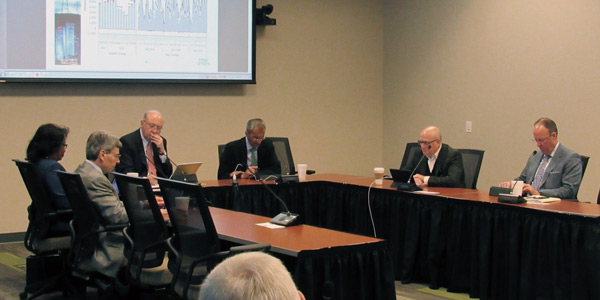By Amanda Durish Cook
CARMEL, Ind. — High generation outage rates in MISO South and suspicions of deliberate over-forecasting by wind operators highlighted the concerns of MISO’s Independent Market Monitor in the fall.
Monitor David Patton presented the draft of his fall report at the Dec. 6 meeting of the Markets Committee of the Board of Directors, saying that MISO’s markets performed “competitively and reliably” with “infrequent” market mitigation.
MISO’s fall load peaked at 115 GW on Sept. 6. Patton said a 15% increase in real-time energy prices from last fall could be traced to a 13% increase in natural gas prices over the same period last year. He said a 4% year-over-year increase in wind output — which set a new record at 13.3 GW of production on Nov. 28 — led to higher congestion and price volatility. Combined with high levels of generator outages, there was higher congestion in the day-ahead and real-time markets relative to last year, Patton said.
Day-ahead congestion increased by 18% over 2015 to $202.7 million and real-time congestion increased by 9% to $345.1 million. “Prices, particularly in the three southern hubs in October jumped up … due to some pretty significant congestion,” Patton said.
Outages Approach 40%
Patton said generation outages in MISO South were of particular concern, increasing from an average of 18.2% in fall 2015 to 31.6% in fall 2016. As October approached, Patton said, MISO South outage rates almost reached 40%. “This is an unusually large quantity to have out,” he said.
Unseasonably warm weather produced unusually high loads and led to a maximum generation alert Oct. 4-5. Patton said the tight conditions were due in part to the high outage rates in MISO South.
“It appears that if we could do anything better as a market, it’s managing the scheduling of the outages in MISO South,” Vice President of System Planning and Seams Coordination Jennifer Curran said.
“That’s fair,” Patton responded, adding that MISO should have more authority over generation outages.
Vice President of System Operations Todd Ramey said high temperatures and the high number of scheduled outages, combined with forced outages and derates, contributed to the reliability concerns.
“As an industry we tend to focus on the winter, but it’s true that the most challenging situations are the shoulder periods where outages are high,” Ramey said. He also said MISO is taking “a hard look” at adjusting outage coordination in MISO South. Jeff Bladen, executive director of market services, said the season proved the value of the North-South transfer path, as the outages were offset by MISO North power.
Curran said the Tariff might need to be “opened up” to give MISO the authority to coordinate planned outages in advance “so you aren’t just responding to the conditions as they’re dealt, but you can influence them.”
Wind Operators’ ‘Bias’
Patton repeated concerns that wind operators were deliberately over-forecasting their supply to earn more from MISO’s day-ahead margin assurance payment. (See MISO IMM Sees Deliberate Over-Forecasting by Wind Operators.)
Board member Baljit Dail asked if Patton had a sense of the size of the overpayments.
Patton said that while he didn’t find gaming had occurred “in an obvious fashion,” he estimated MISO has paid $6 million in unjustified payments over the past year to year and a half. “The [wind operators] are not forecasting badly because they don’t have the technology; they’re forecasting badly because they have a bias,” Patton said.
Richard Doying, MISO’s executive vice president of operations and corporate services, said the RTO continues to evaluate instances of wind over-forecasting and would approach the board with findings and possible solutions later.
Director Phyllis Currie defended the RTO, saying it is looking to put people and resources in place to conduct their own wind forecasts. “Load forecasting is not an exact science,” she pointed out.
Patton agreed that MISO should not rush a solution.
On average in fall 2016, wind units predicted an average day-ahead wind supply of 4,324 MW and produced 5,141 MW in real time.
Patton also told the board that he continues to work with MISO on expanding a pilot program to create temperature-adjusted transmission ratings. “When temperatures are cooler, you can transfer a lot more power,” Patton said.





